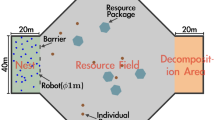Abstract
This paper focuses on the collective cognition by robotic swarms. The robotic swarms expected to perform tasks that are beyond the capability of a single robot by collective behavior that emerge from local interactions, similar to biological swarms. However, the robotic swarms have to rely on the collective cognition more than biological swarms when considering the limitation in sensory capabilities and the cost of each robot. In this paper, we develop controllers for a robotic swarm to accomplish a foraging task that requires collective cognition. In this task, robots have to both collectively distinguish two objects, namely food and poison, and cooperatively transport food objects to the nest. We applied an evolutionary robotics approach with the covariance matrix adaptation evolution strategy to develop controllers for robotic swarms. The results of computer simulations show that collective cognition was successfully developed, which allows the robots to transport only food objects. In addition, we also perform experiments to examine the scalability and the flexibility of the developed controllers.













Similar content being viewed by others
Explore related subjects
Discover the latest articles and news from researchers in related subjects, suggested using machine learning.Notes
Box2D: A 2D Physics Engine for Games. Available on https://box2d.org.
References
Şahin E (2005) Swarm robotics: from sources of inspiration to domains of application. Swarm robotics, Springer, lecture notes in computer science. Springer, Berlin, pp 10–20
Dorigo M, Birattari M, Brambilla M (2014) Swarm robotics. Scholarpedia 9(1):1463
Couzin ID (2009) Collective cognition in animal groups. Trends Cognit Sci 13(1):36–43
Trianni V, Tuci E, Passino KM, Marshall JA (2011) Swarm cognition: an interdisciplinary approach to the study of self-organising biological collectives. Swarm Intell 5(1):3–18
Schmickl T, Möslinger C, Crailsheim K (2006) Collective perception in a robot swarm. International Workshop on Swarm Robotics. Springer, Berlin, pp 144–157
Valentini G, Brambilla D, Hamann H, Dorigo M (2016) Collective perception of environmental features in a robot swarm. International Conference on Swarm Intelligence. Springer, Berlin, pp 65–76
Ebert JT, Gauci M, Nagpal R (2018) Multi-feature collective decision making in robot swarms. In: Proceedings of the 17th International Conference on Autonomous Agents and MultiAgent Systems, International Foundation for Autonomous Agents and Multiagent Systems, pp. 1711–1719.
Nolfi S, Floreano D (2000) Evolutionary robotics: the biology, intelligence, and technology of self-organizing machines. MIT Press, London
Trianni V (2008) Evolutionary swarm robotics: evolving self-organising behaviours in groups of autonomous robots, Studies in Computational Intelligence, vol 108. Springer, Berlin
Brambilla M, Ferrante E, Birattari M, Dorigo M (2013) Swarm robotics: a review from the swarm engineering perspective. Swarm Intell 7(1):1–41
Francesca G, Birattari M (2016) Automatic design of robot swarms: achievements and challenges. Front Robot AI. https://doi.org/10.3389/frobt.2016.00029
Trianni V, Groß R, Labella TH, Şahin E, Dorigo M (2003) Evolving aggregation behaviors in a swarm of robots. European Conference on Artificial Life, Springer, Lecture Notes in Artificial Intelligence. Springer, Berlin, pp 865–874
Soysal O, Bahçeci E, Şahin E (2007) Aggregation in swarm robotic systems: evolution and probabilistic control. Turk J Electr Eng Comput Sci 15(2):199–225
Baldassarre G, Nolfi S, Parisi D (2003) Evolving mobile robots able to display collective behaviors. Artif Life 9(3):255–267
Sperati V, Trianni V, Nolfi S (2011) Self-organised path formation in a swarm of robots. Swarm Intell 5(2):97–119
Hiraga M, Wei Y, Yasuda T, Ohkura K (2018) Evolving autonomous specialization in congested path formation task of robotic swarms. Artif Life Robot 23(4):547–554
Nitschke GS, Schut MC, Eiben A (2012) Evolving behavioral specialization in robot teams to solve a collective construction task. Swarm Evol Comput 2:25–38
Gross R, Dorigo M (2009) Towards group transport by swarms of robots. Int J Bio-Inspir Comput 1(1–2):1–13
Hansen N, Ostermeier A (1996) Adapting arbitrary normal mutation distributions in evolution strategies: the covariance matrix adaptation. In: Proceedings of IEEE International Conference on Evolutionary Computation, 1996, IEEE, pp. 312–317.
Hansen N, Ostermeier A (2001) Completely derandomized self-adaptation in evolution strategies. Evol Comput 9(2):159–195
Hansen N (2016) The CMA evolution strategy: a tutorial. arXiv preprint arXiv:1604.00772
Silva F, Duarte M, Correia L, Oliveira SM, Christensen AL (2016) Open issues in evolutionary robotics. Evol Comput 24(2):205–236
Author information
Authors and Affiliations
Corresponding author
Additional information
Publisher's Note
Springer Nature remains neutral with regard to jurisdictional claims in published maps and institutional affiliations.
About this article
Cite this article
Hiraga, M., Wei, Y. & Ohkura, K. Evolving collective cognition for object identification in foraging robotic swarms. Artif Life Robotics 26, 21–28 (2021). https://doi.org/10.1007/s10015-020-00628-0
Received:
Accepted:
Published:
Issue Date:
DOI: https://doi.org/10.1007/s10015-020-00628-0




